If you’re ready for your business to be a purpose-driven business, the first step is identifying its Purpose Archetype. New Commodity developed the Purpose-Driven Business Archetypes (or Purpose Archetypes) to help businesses define their purpose and put it to work sooner.
Identifying Your Business’s Purpose Archetype
Your business’s core values combined with who or what it exists to serve determines its Purpose Archetype. So to identify your business’s Purpose Archetype, start by considering two dimensions of your business: (1) core values and (2) products or services. For instance, if personal growth is a core value and the business sells fitness products, it may be a Trainer company. However, if your business sells fitness products and equitable access to fitness is a core value, it may be an Advocate company.
How Your Purpose Archetype Works
eliminates the noise
Your business’s Purpose Archetype helps in a few key ways. First, it narrows the focus and leads the business to its purpose statement. By using core values and products or services, you’ll eliminate the noise that distracts and overwhelms leadership when it comes to identifying purpose.
Take the story of a small restaurant group we worked with recently. The noise around the leadership told them that their purpose should be sustainable ingredient sourcing. They operated from that purpose for a few years, but it just wasn’t landing. Instead, a look at their values, products, and service helped them identify as a Nurturer company. From that Purpose Archetype, the restaurant group articulated a purpose statement that helped them focus and build on what makes them stand out in their market. Sustainable ingredient sourcing is an important part of the company’s business model, by the way. But their purpose is to develop the next generation of great leaders in the workforce.
connects with stakeholders
Traditional archetypes make it easy for us to understand and connect with a character, politician, or TV personality. So Purpose Archetypes make it easy for your stakeholders to quickly understand and connect with your business. When stakeholders easily understand and connect with your business, they’re more likely to commit to your business for the long-term.
The restaurant group’s Purpose Archetype helped them connect with their stakeholders by showing them great leadership in every interaction with the business. Customers experience their purpose of developing great leaders when they interact with kind and engaging staff members. They notice attention to quality when they taste the food and enjoy healthy ingredients. Likewise, suppliers experience kind and engaging buyers who are focused on building long-term relationships. And of course, employees are working in an environment of skill building and growth.
improves operations
The difference between a business that has a purpose statement and one that is purpose-driven is aligned operations. Of course purpose-driven businesses need to have a positive impact externally. But they also need to thrive as a business. This alignment is what drives the business outcomes and value that stem from purpose.
In a different example, consider an events company we worked with. Experiencing a leadership transition and changes forced by COVID, they needed to streamline and improve operations. Identifying as a Builder company, they were able to focus their operating resources on what they do best: creating space for entrepreneurs to grow. They also saw potential for expanded service offerings when they considered what it meant to be a Builder company.
Going Beyond the Purpose Statement
For businesses that strive to be truly purpose-driven, the purpose statement is only the beginning. Understanding the archetype behind your business’s purpose statement helps bring it to life in operations. Or, if your business is struggling to find clarity of purpose, discovering its Purpose Archetype will help generate an authentic and compelling purpose statement. Either way, it’s putting your purpose to work that counts.






